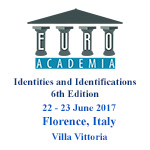Euroacademia Conferences
 Europe Inside-Out: Europe and Europeanness Exposed to Plural Observers (9th Edition) April 24 - 25, 2020
Europe Inside-Out: Europe and Europeanness Exposed to Plural Observers (9th Edition) April 24 - 25, 2020 Identities and Identifications: Politicized Uses of Collective Identities (9th Edition) June 12 - 13, 2020
Identities and Identifications: Politicized Uses of Collective Identities (9th Edition) June 12 - 13, 2020 8th Forum of Critical Studies: Asking Big Questions Again January 24 - 25, 2020
8th Forum of Critical Studies: Asking Big Questions Again January 24 - 25, 2020 Re-Inventing Eastern Europe (7th Edition) December 13 - 14, 2019
Re-Inventing Eastern Europe (7th Edition) December 13 - 14, 2019 The European Union and the Politicization of Europe (8th Edition) October 25 - 26, 2019
The European Union and the Politicization of Europe (8th Edition) October 25 - 26, 2019 Identities and Identifications: Politicized Uses of Collective Identities (8th Edition) June 28 - 29, 2019
Identities and Identifications: Politicized Uses of Collective Identities (8th Edition) June 28 - 29, 2019 The European Union and the Politicization of Europe (7th Edition) January 25 - 26, 2019
The European Union and the Politicization of Europe (7th Edition) January 25 - 26, 2019 7th Forum of Critical Studies: Asking Big Questions Again November 23 - 24, 2018
7th Forum of Critical Studies: Asking Big Questions Again November 23 - 24, 2018 Europe Inside-Out: Europe and Europeanness Exposed to Plural Observers (8th Edition) September 28 - 30, 2018
Europe Inside-Out: Europe and Europeanness Exposed to Plural Observers (8th Edition) September 28 - 30, 2018 Identities and Identifications: Politicized Uses of Collective Identities (7th Edition) June 14 - 15, 2018
Identities and Identifications: Politicized Uses of Collective Identities (7th Edition) June 14 - 15, 2018
Only of Local Significance? The German Artist Otto Hettner (1875-1931) between Dresden and Europe
-
-

-
Presentation speakers
- Kati Renner, Technische Universität Dresden, Germany
- Download presentation
Abstract:
“Only of local significance” has been the devastating judgment of the National Gallery in Berlin, with which some artworks offered of the estate had been rejected. Surprisingly, this decision ignored important life stages and the influence of this artist. The Dresden-based artist Hettner has spent nearly ten years in the vibrant metropolis Paris and between 1905 and 1911 in the emerging city of Florence. He was married to a French woman, built up an international network with artists and poets such as Edvard Munch, Auguste Rodin, Henri de Groux, Ardengo Soffici and Theodor Däubler and had a significant influence on the artistic exchange between Dresden, Paris and Florence. He was living a life of a typical European artist around 1900, searching for his individual, but also for a new national style. However, as displayed artworks in certain museums show, he is nowadays solely considered as an artist of regional significance. This classification is based on the fragmentary character of his oeuvre, which formerly comprised around 4.300 artworks and today consists of just a few paintings and graphics. Having been exhibited in 1932 for the last time, removed from museums as “degenerated artist” and his estate mostly being destroyed during the II. World War, the artist’s identification has changed dramatically. This paper aims to discuss critically this construction / deconstruction of an artist’s local, national and international identity using Otto Hettner as a significant example. Furthermore, this example highlights a general process of national art around 1900 in Europe shaping a nation’s identity: through appropriation and transformation of French and Italian influences especially German artists such as Hettner sought not only to develop an individual artistic style, but also, in contradiction to their transnational biography and in competition with other nations, creating a specific national one.
-
Related Presentations













